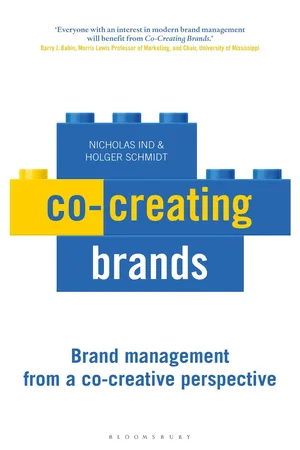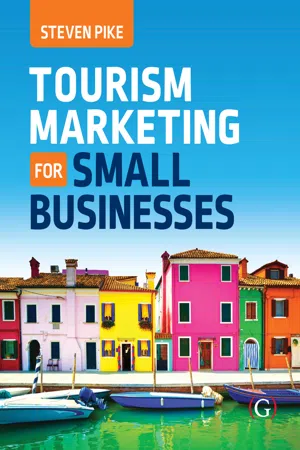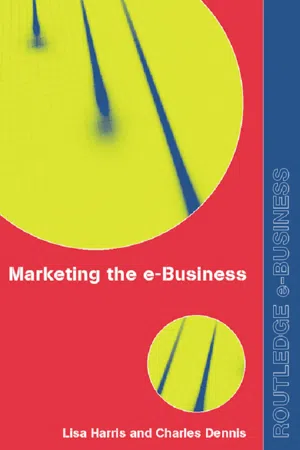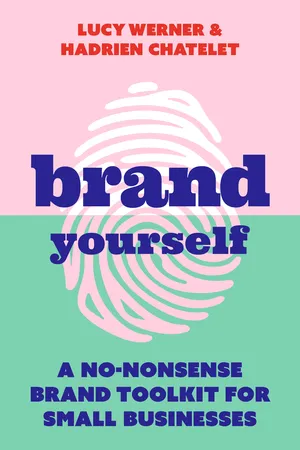Marketing
Branding strategy
Branding strategy refers to the plan and approach a company uses to create a unique and memorable identity for its products or services. It involves defining the brand's values, positioning, and messaging to differentiate it from competitors and resonate with the target audience. A well-crafted branding strategy can help build customer loyalty and drive business growth.
Written by Perlego with AI-assistance
Related key terms
1 of 5
10 Key excerpts on "Branding strategy"
- eBook - PDF
Co-creating Brands
Brand Management from A Co-creative Perspective
- Nicholas Ind, Holger J. Schmidt(Authors)
- 2019(Publication Date)
- Bloomsbury Business(Publisher)
166 CH APTER SE VEN Defining and adjusting brand strategy In this chapter… A brand strategy should be closely inter-connected with the organisational strategy. The two should be mutually supportive, so that the organisational strategy sets the context for the brand strategy and it, in turn, enables the organisational strategy to be realised. The brand strategy indicates what a brand stands for today and in what direction brand managers want to develop the brand in the future. The brand’s identity and its positioning are part of the brand strategy. A brand identity is a summary of the most important connotations associated with the brand and addresses what a brand stands for in the eyes of internal stakeholders. It also asks how it is understood in terms of its image in the eyes of external stakeholders. Under the co-creative perspective, brand identity is not a fixed asset that gets written down once and then remains untouched – a brand’s identity is subject to constant mediation and re-interpretation as the brand’s meaning is co-created by its employees, customers and by others. Nevertheless, brand managers are well advised to clearly define their brand’s identity, because a profound understanding of the brand is needed internally as a starting point from which to stimulate and facilitate the co-creation of brand meaning within certain limits. For the purpose of clarity and for internal purposes (teaching new employees about the brand or briefing an advertising agency, for example), various models exist that show and explain how a brand identity can be formulated in a practical manner. Some of the 167 Defining and adjusting brand strategy models are concrete and some more abstract, but they are widely used by practitioners. A brand’s positioning is based on its identity, but also follows a more tactical approach. A positioning aims to provide continuity of brand experience, adapted to various target groups throughout all brand touch points. - eBook - PDF
Marketing Management
A Value-Creation Process
- Alain Jolibert, Hans Mühlbacher, Laurent Flores, Pierre-Louis Dubois(Authors)
- 2017(Publication Date)
- Red Globe Press(Publisher)
Depending on the perspective taken by brand managers, brand building and brand monitoring will be executed in different ways. Branding refers to all activities of an organization, its stakeholders and competitors that focus on creating, generating, influencing and using/consuming the value of the organization and its exchange offer(s). In strategic branding, management • searches for, determines and disseminates their objectives concerning the brand to all members of their organization, • defines the intended meaning of the brand to the various stakeholders, the central intended manifestations of brand meaning and the most important intended partners in creating and generating the intended meaning, • lays the foundations for coherently developing, acquiring or making available the capabilities to support the development of intended brand meaning, manifestations and relationships with important branding partners, • allocates scarce resources of their organization in a coordinated way and STRATEGIC BRANDING 175 • monitors the outcomes of the above mentioned activities. Strategic branding is central to the long-term survival of an organization because strong brands are • valuable, in the sense of positively attracting stakeholders who possess skills and resources that are important for carrying out the mission of the organization and • impossible to imitate because of their specific meanings. Further reading Holt, D.B. and D. Cameron (2010), Cultural Strategy: Using Innovative Ideologies to Build Breakthrough Brands (Oxford: Oxford University Press). Kapferer, J.-N. (2008), The New Strategic Brand Management: Creating and Sustaining Brand Equity Long Term , 4th edn (London: Kogan Page). Schroeder, J.E. and M. Salzer-Mörling (eds.) (2006), Brand Culture (London: Routledge). Notes and references 1 P. Kotler and G. Armstrong (2006), Principles of Marketing , 11th edn (Englewood Cliffs, NJ: Pearson Prentice-Hall). - eBook - PDF
- Steven Pike(Author)
- 2018(Publication Date)
- Goodfellow Publishers(Publisher)
Then ask your friends what thoughts first come to mind when you mention this brand? Their responses will be representative of any associations they have with the brand in their mind. If they haven’t heard of the brand then clearly there are no associations. What are the implications of the responses for marketers? Branding as a co-creative process While there is no universal agreement on the definition of a brand, most are typi-cally a variation of the following: A name, logo, and slogan designed to differentiate a specific product or service from competitors. However, branding is much more complex than designing a name, logo and slogan, even though these are fundamental to the success of the brand. Following Berthon et al. (1999), Keller (2003), and Blain et al. (2005), tourism branding is described as the set of marketing activities designed to: Support the design of a name, logo and slogan, which identify and differenti-ate a tourism service from competitors, Reduce the level of perceived financial and emotional risk for consumers, and Create expectations of, and deliver, a memorable experience. This perspective acknowledges both the marketer and the consumer as being involved in co-creating the brand, remembering that any measure of brand equity is based on market perceptions. With this in mind, it is useful to consider branding as comprising the three key elements of brand identity, brand image, and brand positioning, as highlighted in Figure 7.1. The brand identity is the image aspired to by the organisation in the market place. Brand image is the actual perceptions held Tourism Marketing for Small Businesses 110 of the brand by consumers, which might or might not be similar to that intended in the brand identity. Brand positioning is the attempt by marketers to achieve congruence between the brand identity and the brand image. - eBook - ePub
- Charles Dennis, Lisa Harris(Authors)
- 2002(Publication Date)
- Routledge(Publisher)
Chapter 5
Branding
Geraldine Cohen and Lisa Harris MindmapLinks to other Chapters
• Chapter 4 – Strategy• Chapter 6 – Relationship marketing• Chapter 7 – Multi-channel marketingKey Learning Points
After completing this chapter you will have an understanding of :• The increasingly broad scope of branding which can encompass whole corporations or even business partnerships as well as specific products • The range of branding strategies available to companies seeking to establish their brands online • The emerging challenges inherent in multi-channel brandingOrdered List of Sub Topics
• What is a brand? • The scope of branding • Global v. local branding • Key trends in branding • Online branding strategies• Offline brand reinforcement • Brand creation • Brand followers • Brand repositioning • Co-branding• Building brand awareness • Brand convergence • Chapter summary • Case study: Ergobank • Further reading • Questions • Web linksWHAT IS A BRAND?
Kotler et al. provide the following rather pragmatic definition of a brand:Olins is rather more emotive with this description:A brand is a name, term, sign, symbol, design, or a combination of these which is used to identify the goods or services of one seller or group of sellers and to differentiate them from those of the competitors.(2001: 469)Branding reaches beyond immediate commercial objectives and touches the soul. (1999: 128)Consumers are surrounded by brands in all walks of life, so what makes a successful brand among the clutter? According to Aldisert, ‘Branding is not about getting your prospect to choose you over the competition; it’s about getting your prospect to see you as the only solution’ (1999: 36).Large sums of money are invested each year in order to create and maintain the awareness of and the preference for a brand. Powerful brands command unwavering consumer loyalty and provide strong competitive advantage in the marketplace: - eBook - ePub
Star Brands
A Brand Manager's Guide to Build, Manage & Market Brands
- Carolina Rogoll(Author)
- 2015(Publication Date)
- Allworth(Publisher)
STAR BRANDS STEP FOUR Establishing the Marketing StrategyPassage contains an image
9M arketing Strategy & Mix“Marketing is still an art, and the marketing manager, as head chef, must creatively marshal all his marketing activities to advance the short and long-term interests of his firm.” —Neil H. Borden, 1984Marketing strategy is the process of creating a plan to deliver the brand’s goals of increasing sales and building sustainable brand value. The marketing strategy process requires the previous four steps in the Star Brand Model—brand assessment and goal setting, equity definition, target definition, and the brand’s IBI—as well as the marketing mix and a measurement plan that we are about to study.MARKETING MIXGiven the breadth of components of the marketing strategy and considering that it is a process, we will discuss it across a few chapters, starting from the theory and then moving into putting it into practice. We will begin with an overview of the different components of marketing strategy manifested as the marketing mix. Then we will discuss how to select the right marketing mix to deliver a brand’s goal based on what drives effectiveness of each component. With the theory covered, we can go through the steps of building a marketing plan that will turn all the five steps of the Star Brand Model into action to grow your brand. In the last chapter, we will go through how to create a measurement plan to track your brand-building progress and adjust it as needed so you can deliver your ultimate goal. Let’s begin.A core step in developing the marketing strategy for a brand is defining and selecting its marketing mix, which is simply the combination of resources and tactics that can be controlled by a brand to generate sales or build brand awareness. Getting the combination of factors just right, maximizing the return on your investment in getting your product and message out into the world, is one of the biggest challenges a brand manager faces. - eBook - PDF
Asian Brand Strategy
How Asia Builds Strong Brands
- M. Roll(Author)
- 2005(Publication Date)
- Palgrave Macmillan(Publisher)
A brand is a trademark and marque (logo, shape, color and so on) which is fiercely and proactively protected by the company and its legal advisors Source: VentureRepublic Psychological research demonstrates that brands are durable because people are cognitive misers. Modern society is overloaded with informa- tion, and the average person receives far more information than one can possibly digest properly. Therefore people seek to simplify the world by relying on a variety of heuristics to minimize the amount of searching and information processing needed to make reasonable decisions. Once people believe that a brand works for a certain purpose or reason, they are less likely to seek out new information that challenges that assumption. Socio- logical research also demonstrates why people are less likely to switch brands. Many elements – images, stories and associations – are attached to a brand. As these elements are shared collectively by groups and networks of people, they form generally accepted conventions about brands. It is therefore relatively difficult for individuals to switch brands and thereby abandon these shared conventions. 3 14 Asian Brand Strategy There is a distinct difference between companies, products and services of which customers might be aware, and real brands with strong brand equity. Therefore, strong brands are more than trademarks and trade names (logos that identify the products and services). Before delving into an analysis of branding, it is important to get the branding terminology right. “Branding” is a widely misused and misunderstood term, around which clusters everything even vaguely related to strategy, marketing and communication. Branding is an investment that must be perceived as such and is required to deliver ROI and shareholder value like any other feasible business activity. It must appear on the left side of the balance sheet as an intangible asset and its value is subject to change upward and potentially downward. - eBook - ePub
What's in a Name?
Advertising and the Concept of Brands
- David M Jones, Jan S. Slater(Authors)
- 2014(Publication Date)
- Routledge(Publisher)
There are many people involved with the brand. Whether those involved work for the manufacturer or for the advertising agency, they are the stewards of this brand. It is their job to protect, maintain, and strengthen it. Therefore, it is extremely important that all involved understand and agree on the direction of the brand’s advertising strategy. Without this type of endorsement and agreement, the opportunity for misuse of resources, missed opportunities, or misguided creative executions is greatly increased.4. A strategy provides a benchmarkAccountability is a very big issue in advertising today. With the spending levels in the business, it is unpardonable not to understand the impact of the investment. A strategy provides the grounding for determining the success of the advertising campaign. It serves this purpose when the campaign is implemented and during the development of advertising executions and their deployment in the marketplace. The strategy acts as the measure of whether the message strategy, the creative executions, and the media plan reflect the target audience, the basic argument, and the purpose of the advertisement.Formulating the Strategy
The process of developing a strategy involves gathering, processing, and analyzing information as it pertains to the brand. The strategy itself is brief—one or two pages at the most. But to develop the strategy, much work has to be done. This varies depending on the agency’s history with the brand. Much can be said about the power of experience. However, it is quite easy to fall prey to the attitude of “we’ve always done it this way.” The process of reanalyzing information is a good one, simply to make certain you are up to date on new developments and are not jumping to conclusions that the facts do not support.The first step in the process is information gathering and analysis, and from this problems and opportunities can be identified. In agencies, account planners or account executives are responsible for this process, and most have their own formats for organizing the information for the strategy. People learning about the business, however, find the process quite perplexing. When confronted with developing a strategy, beginners have difficulty in determining just what information is needed to make a decision. It takes time to acquire the critical thinking skills needed to sort out the most important information and provide analysis, not just description. We propose below a practical framework that can aid veterans or rookies in the process of analyzing the situation from which the strategy will evolve. This framework is a brand audit. - eBook - ePub
Brand Yourself
A no-nonsense brand toolkit for small businesses
- Lucy Werner, Hadrien Chatelet(Authors)
- 2021(Publication Date)
- Practical Inspiration Publishing(Publisher)
define his personality; it is simply another element that makes up the tapestry of who he is. If you were to take the clothes away, brand Hadrien still exists (albeit slightly chillier). It should be the same with your own brand.Another misconception we often come across is that the brand is the product. Again, this is only one small part of the overall picture – branding isn’t about something physical or tangible. Flyers, marketing materials and the way your product looks and feels can operate as part of the promotional tool of the brand, but they don’t embody the emotion and feeling of the overarching brand.As we can see from all of these misconceptions, there’s a common thread: a lot of small businesses think that branding is about the visual appearance of their business. And absolutely, having a good-looking website and an identifiable colour palette is going to help you – but this isn’t what branding actually is. These things come from decisions you make about how to use your brand – in other words, your visual identity comes from your brand strategy .The brand strategy is the business plan for your brand. When you create your brand, you need to think about what you want your audience to feel.So, let’s dive straight in to how to build your brand strategy. BRAND STRATEGYLet’s take the concept of a book. You start with a preface or an introduction. This first part, like where we introduced ourselves to you, is where we set the scene. We explain where you are, where and who we are and where we’re going to go together. Creating the brand is just that. It is scene-setting for your business. It’s the look and feel, the culture. But more than that, it is the feeling, the heart, the emotion of the people that your audience get to experience when they work with you or buy from you.This is the most important part of your branding exercise. There are millions of ways you can execute your brand to appeal to all of the senses, and millions of ways that brands can give you different emotions or connections with their audience. But there are only a few ways that are going to be successful for you. That is what we are trying to find – the exact set of conditions where your brand speaks in the right way, saying the right things, to the right audience. - eBook - PDF
- Amy Will(Author)
- 2021(Publication Date)
- For Dummies(Publisher)
When you’re building and launching a brand, you need to move your brand to a position that gives it the greatest chance for success. This process usually involves identifying or developing brand attri-butes that enable you to outcompete what’s already available. Suppose that you’re planning to open a restaurant in your neighborhood, which already has plenty of diverse restaurants — fine dining, fast food, Chinese, Mexican, Italian, Thai, Greek, Japanese, cafés, bars and grills, buffets, you name it. How can you possibly compete? You look for ways to make your restaurant dif-ferent and better, such as the following: » Higher-quality food » Generous servings » Superior service » Relaxed atmosphere » Convenient location » Lower prices » Free entertainment Then you can begin to market these attributes to build brand recognition and awareness. ( Brand recognition involves the ability to identify a brand by its logo, colors, slogan, tagline, jingle, or other brand attribute. Brand awareness is deeper knowledge of the brand, such as its mission and the products or services offered.) In this section, I lead you through the process of positioning your brand. Choosing a brand positioning strategy You start the brand positioning process by choosing one or more brand position-ing strategies. A brand positioning strategy is an approach to differentiating some -thing from what’s already available. A brand positioning strategy could be to offer the lowest prices or the highest-quality product in its class. When choosing a brand positioning strategy, think about your brand’s unique selling proposition (USP) — what makes your brand different, better, and more attractive to customers. CHAPTER 3 Positioning and Defining Your Brand 45 In this section, I highlight several brand positioning strategies, but this list isn’t exhaustive by any means. - eBook - PDF
Pharmaceuticals-Where's the Brand Logic?
Branding Lessons and Strategy
- Giles David Moss(Author)
- 2016(Publication Date)
- CRC Press(Publisher)
Chapter 2 What Is Branding? Branding can be extremely confusing to the pharmaceutical mar- keter. What all the consumer books talk about isn’t easy to relate to day-to-day activities. The most useful article on the subject appeared in the Journul ofBrcind Mcrncigernerit and was written by a member of the editorial board, Dannielle Blumenthal.’ In just a few pages, she beautifully describes the reasons for the confusion around a brand and, therefore, branding-it is the direct result of a turf war between a whole host of interested parties who want to make money out of the concept. There is no universal agreement on what a brand is, what you can expect to get from it, or how to make it more profitable for your company. It is in the interests of brand gurus, brand consultants, management consultants, organizational development consultants, advertising agencies, and business schools to be seen as the experts in this highly visible area. Everyone is busy selling their particular niche expertise, claiming unusual insight into a complicated area, presumably making themselves piles of cash, but muddying the waters as they go. Having said that, it’s worth stating a few definitions as a way of il- lustrating that there are definitions of real value out there and they can make sense. They aren’t quite picked at random: Branding is “a set of consistent processes, aimed at a specific purpose, that define, differentiate, and add value to the organiza- tion? A brand “is a name or a symbol given to a product that will dif- ferentiate it versus other products and that will register it in the P1iurmciceuticd.v- Where’s the Brand Logic? Published by The Haworth Press, Inc., 2007. All rights reserved. doi: 10. I300/5836-02 19
Index pages curate the most relevant extracts from our library of academic textbooks. They’ve been created using an in-house natural language model (NLM), each adding context and meaning to key research topics.









